ORG20002 Business & Society: Exploring CSR and CSV Concepts
VerifiedAdded on 2023/05/30
|11
|2959
|113
Essay
AI Summary
This essay provides a comprehensive analysis of Corporate Social Responsibility (CSR) and Creating Shared Value (CSV) within the framework of business and society. It delves into the definitions, explanations, and practical applications of both concepts, highlighting their different approaches to business and their impact on various stakeholders. The essay uses examples such as Nestle, Wal-Mart, Tesco, and Adidas to illustrate the implementation and effectiveness of CSR and CSV strategies. It also discusses the rise of multinational corporations, socioeconomic and environmental issues, and the key differences between CSR as a cost to the company and CSV as a strategy for creating shared value and long-term sustainability, emphasizing the importance of stakeholder engagement and ethical business practices. Desklib is a platform where students can find similar solved assignments and past papers.
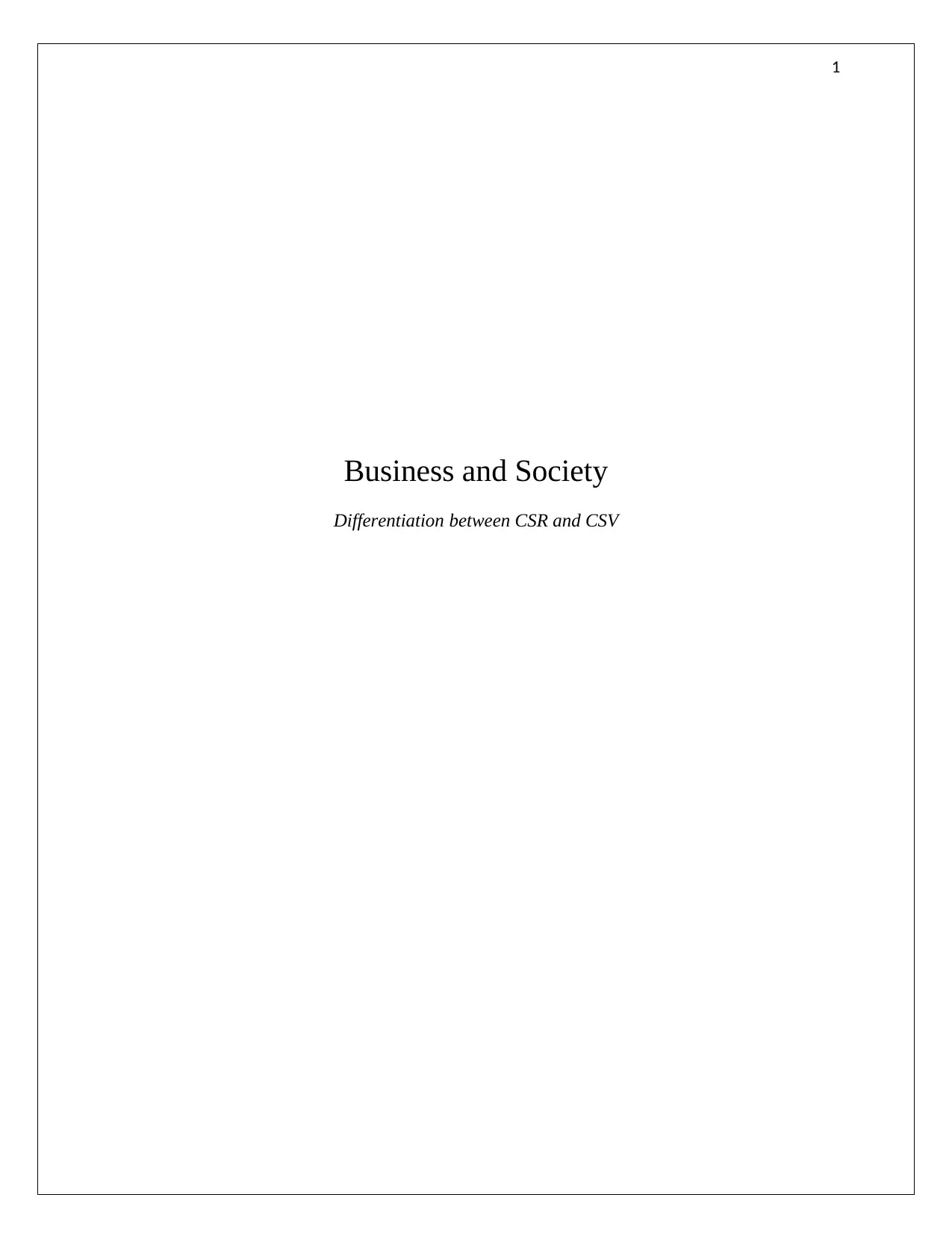
1
Business and Society
Differentiation between CSR and CSV
Business and Society
Differentiation between CSR and CSV
Paraphrase This Document
Need a fresh take? Get an instant paraphrase of this document with our AI Paraphraser
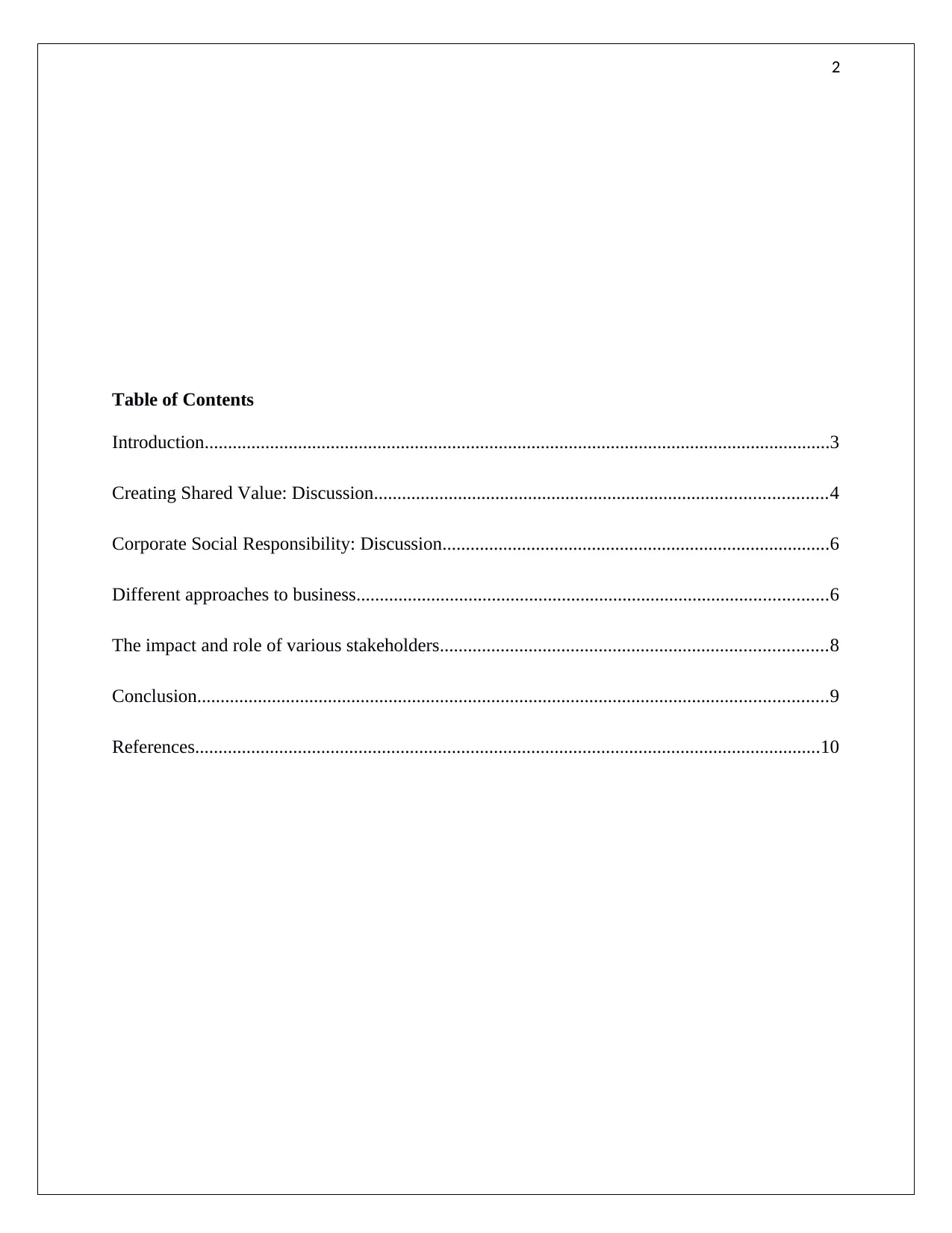
2
Table of Contents
Introduction......................................................................................................................................3
Creating Shared Value: Discussion.................................................................................................4
Corporate Social Responsibility: Discussion...................................................................................6
Different approaches to business.....................................................................................................6
The impact and role of various stakeholders...................................................................................8
Conclusion.......................................................................................................................................9
References......................................................................................................................................10
Table of Contents
Introduction......................................................................................................................................3
Creating Shared Value: Discussion.................................................................................................4
Corporate Social Responsibility: Discussion...................................................................................6
Different approaches to business.....................................................................................................6
The impact and role of various stakeholders...................................................................................8
Conclusion.......................................................................................................................................9
References......................................................................................................................................10
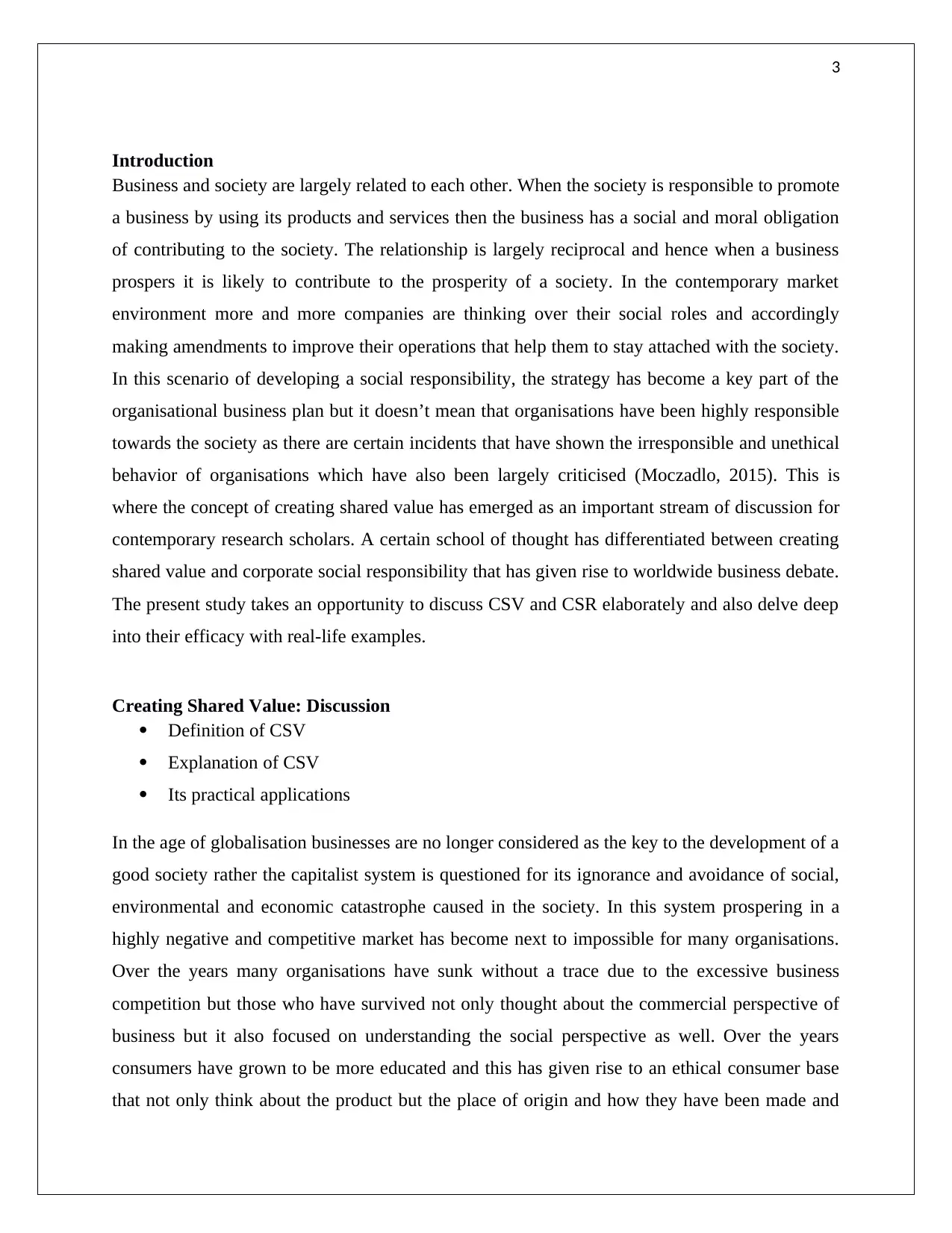
3
Introduction
Business and society are largely related to each other. When the society is responsible to promote
a business by using its products and services then the business has a social and moral obligation
of contributing to the society. The relationship is largely reciprocal and hence when a business
prospers it is likely to contribute to the prosperity of a society. In the contemporary market
environment more and more companies are thinking over their social roles and accordingly
making amendments to improve their operations that help them to stay attached with the society.
In this scenario of developing a social responsibility, the strategy has become a key part of the
organisational business plan but it doesn’t mean that organisations have been highly responsible
towards the society as there are certain incidents that have shown the irresponsible and unethical
behavior of organisations which have also been largely criticised (Moczadlo, 2015). This is
where the concept of creating shared value has emerged as an important stream of discussion for
contemporary research scholars. A certain school of thought has differentiated between creating
shared value and corporate social responsibility that has given rise to worldwide business debate.
The present study takes an opportunity to discuss CSV and CSR elaborately and also delve deep
into their efficacy with real-life examples.
Creating Shared Value: Discussion
Definition of CSV
Explanation of CSV
Its practical applications
In the age of globalisation businesses are no longer considered as the key to the development of a
good society rather the capitalist system is questioned for its ignorance and avoidance of social,
environmental and economic catastrophe caused in the society. In this system prospering in a
highly negative and competitive market has become next to impossible for many organisations.
Over the years many organisations have sunk without a trace due to the excessive business
competition but those who have survived not only thought about the commercial perspective of
business but it also focused on understanding the social perspective as well. Over the years
consumers have grown to be more educated and this has given rise to an ethical consumer base
that not only think about the product but the place of origin and how they have been made and
Introduction
Business and society are largely related to each other. When the society is responsible to promote
a business by using its products and services then the business has a social and moral obligation
of contributing to the society. The relationship is largely reciprocal and hence when a business
prospers it is likely to contribute to the prosperity of a society. In the contemporary market
environment more and more companies are thinking over their social roles and accordingly
making amendments to improve their operations that help them to stay attached with the society.
In this scenario of developing a social responsibility, the strategy has become a key part of the
organisational business plan but it doesn’t mean that organisations have been highly responsible
towards the society as there are certain incidents that have shown the irresponsible and unethical
behavior of organisations which have also been largely criticised (Moczadlo, 2015). This is
where the concept of creating shared value has emerged as an important stream of discussion for
contemporary research scholars. A certain school of thought has differentiated between creating
shared value and corporate social responsibility that has given rise to worldwide business debate.
The present study takes an opportunity to discuss CSV and CSR elaborately and also delve deep
into their efficacy with real-life examples.
Creating Shared Value: Discussion
Definition of CSV
Explanation of CSV
Its practical applications
In the age of globalisation businesses are no longer considered as the key to the development of a
good society rather the capitalist system is questioned for its ignorance and avoidance of social,
environmental and economic catastrophe caused in the society. In this system prospering in a
highly negative and competitive market has become next to impossible for many organisations.
Over the years many organisations have sunk without a trace due to the excessive business
competition but those who have survived not only thought about the commercial perspective of
business but it also focused on understanding the social perspective as well. Over the years
consumers have grown to be more educated and this has given rise to an ethical consumer base
that not only think about the product but the place of origin and how they have been made and
⊘ This is a preview!⊘
Do you want full access?
Subscribe today to unlock all pages.

Trusted by 1+ million students worldwide
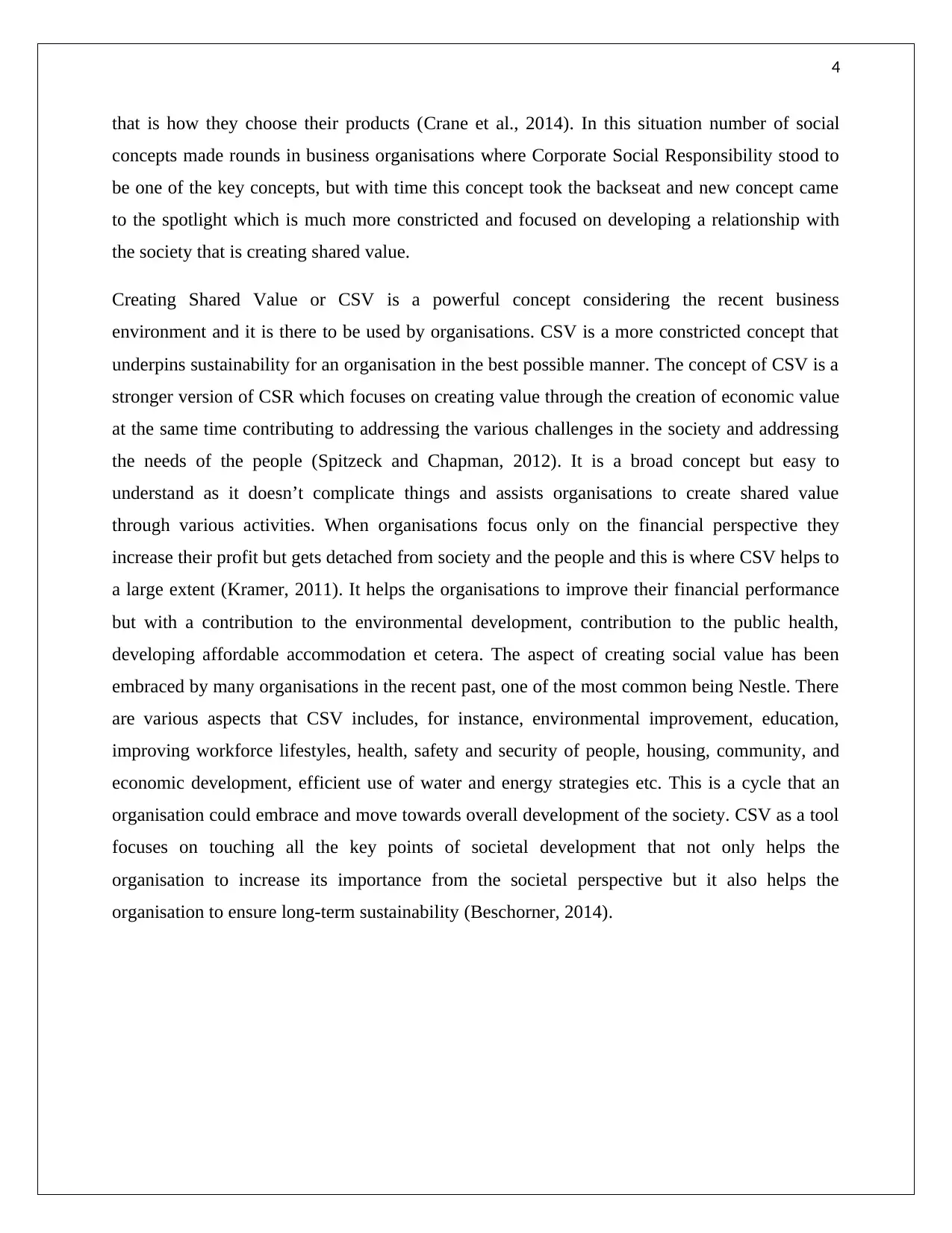
4
that is how they choose their products (Crane et al., 2014). In this situation number of social
concepts made rounds in business organisations where Corporate Social Responsibility stood to
be one of the key concepts, but with time this concept took the backseat and new concept came
to the spotlight which is much more constricted and focused on developing a relationship with
the society that is creating shared value.
Creating Shared Value or CSV is a powerful concept considering the recent business
environment and it is there to be used by organisations. CSV is a more constricted concept that
underpins sustainability for an organisation in the best possible manner. The concept of CSV is a
stronger version of CSR which focuses on creating value through the creation of economic value
at the same time contributing to addressing the various challenges in the society and addressing
the needs of the people (Spitzeck and Chapman, 2012). It is a broad concept but easy to
understand as it doesn’t complicate things and assists organisations to create shared value
through various activities. When organisations focus only on the financial perspective they
increase their profit but gets detached from society and the people and this is where CSV helps to
a large extent (Kramer, 2011). It helps the organisations to improve their financial performance
but with a contribution to the environmental development, contribution to the public health,
developing affordable accommodation et cetera. The aspect of creating social value has been
embraced by many organisations in the recent past, one of the most common being Nestle. There
are various aspects that CSV includes, for instance, environmental improvement, education,
improving workforce lifestyles, health, safety and security of people, housing, community, and
economic development, efficient use of water and energy strategies etc. This is a cycle that an
organisation could embrace and move towards overall development of the society. CSV as a tool
focuses on touching all the key points of societal development that not only helps the
organisation to increase its importance from the societal perspective but it also helps the
organisation to ensure long-term sustainability (Beschorner, 2014).
that is how they choose their products (Crane et al., 2014). In this situation number of social
concepts made rounds in business organisations where Corporate Social Responsibility stood to
be one of the key concepts, but with time this concept took the backseat and new concept came
to the spotlight which is much more constricted and focused on developing a relationship with
the society that is creating shared value.
Creating Shared Value or CSV is a powerful concept considering the recent business
environment and it is there to be used by organisations. CSV is a more constricted concept that
underpins sustainability for an organisation in the best possible manner. The concept of CSV is a
stronger version of CSR which focuses on creating value through the creation of economic value
at the same time contributing to addressing the various challenges in the society and addressing
the needs of the people (Spitzeck and Chapman, 2012). It is a broad concept but easy to
understand as it doesn’t complicate things and assists organisations to create shared value
through various activities. When organisations focus only on the financial perspective they
increase their profit but gets detached from society and the people and this is where CSV helps to
a large extent (Kramer, 2011). It helps the organisations to improve their financial performance
but with a contribution to the environmental development, contribution to the public health,
developing affordable accommodation et cetera. The aspect of creating social value has been
embraced by many organisations in the recent past, one of the most common being Nestle. There
are various aspects that CSV includes, for instance, environmental improvement, education,
improving workforce lifestyles, health, safety and security of people, housing, community, and
economic development, efficient use of water and energy strategies etc. This is a cycle that an
organisation could embrace and move towards overall development of the society. CSV as a tool
focuses on touching all the key points of societal development that not only helps the
organisation to increase its importance from the societal perspective but it also helps the
organisation to ensure long-term sustainability (Beschorner, 2014).
Paraphrase This Document
Need a fresh take? Get an instant paraphrase of this document with our AI Paraphraser
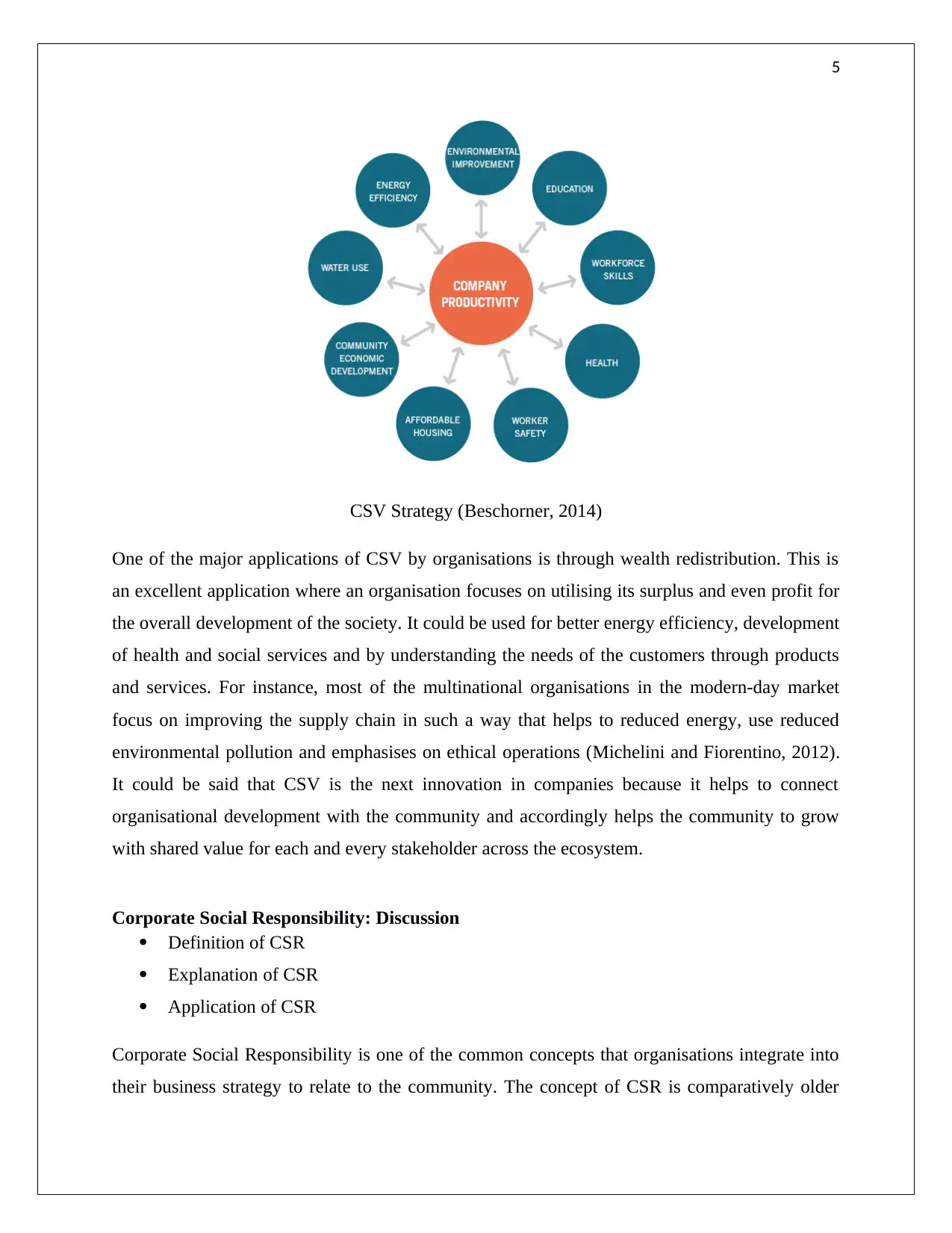
5
CSV Strategy (Beschorner, 2014)
One of the major applications of CSV by organisations is through wealth redistribution. This is
an excellent application where an organisation focuses on utilising its surplus and even profit for
the overall development of the society. It could be used for better energy efficiency, development
of health and social services and by understanding the needs of the customers through products
and services. For instance, most of the multinational organisations in the modern-day market
focus on improving the supply chain in such a way that helps to reduced energy, use reduced
environmental pollution and emphasises on ethical operations (Michelini and Fiorentino, 2012).
It could be said that CSV is the next innovation in companies because it helps to connect
organisational development with the community and accordingly helps the community to grow
with shared value for each and every stakeholder across the ecosystem.
Corporate Social Responsibility: Discussion
Definition of CSR
Explanation of CSR
Application of CSR
Corporate Social Responsibility is one of the common concepts that organisations integrate into
their business strategy to relate to the community. The concept of CSR is comparatively older
CSV Strategy (Beschorner, 2014)
One of the major applications of CSV by organisations is through wealth redistribution. This is
an excellent application where an organisation focuses on utilising its surplus and even profit for
the overall development of the society. It could be used for better energy efficiency, development
of health and social services and by understanding the needs of the customers through products
and services. For instance, most of the multinational organisations in the modern-day market
focus on improving the supply chain in such a way that helps to reduced energy, use reduced
environmental pollution and emphasises on ethical operations (Michelini and Fiorentino, 2012).
It could be said that CSV is the next innovation in companies because it helps to connect
organisational development with the community and accordingly helps the community to grow
with shared value for each and every stakeholder across the ecosystem.
Corporate Social Responsibility: Discussion
Definition of CSR
Explanation of CSR
Application of CSR
Corporate Social Responsibility is one of the common concepts that organisations integrate into
their business strategy to relate to the community. The concept of CSR is comparatively older
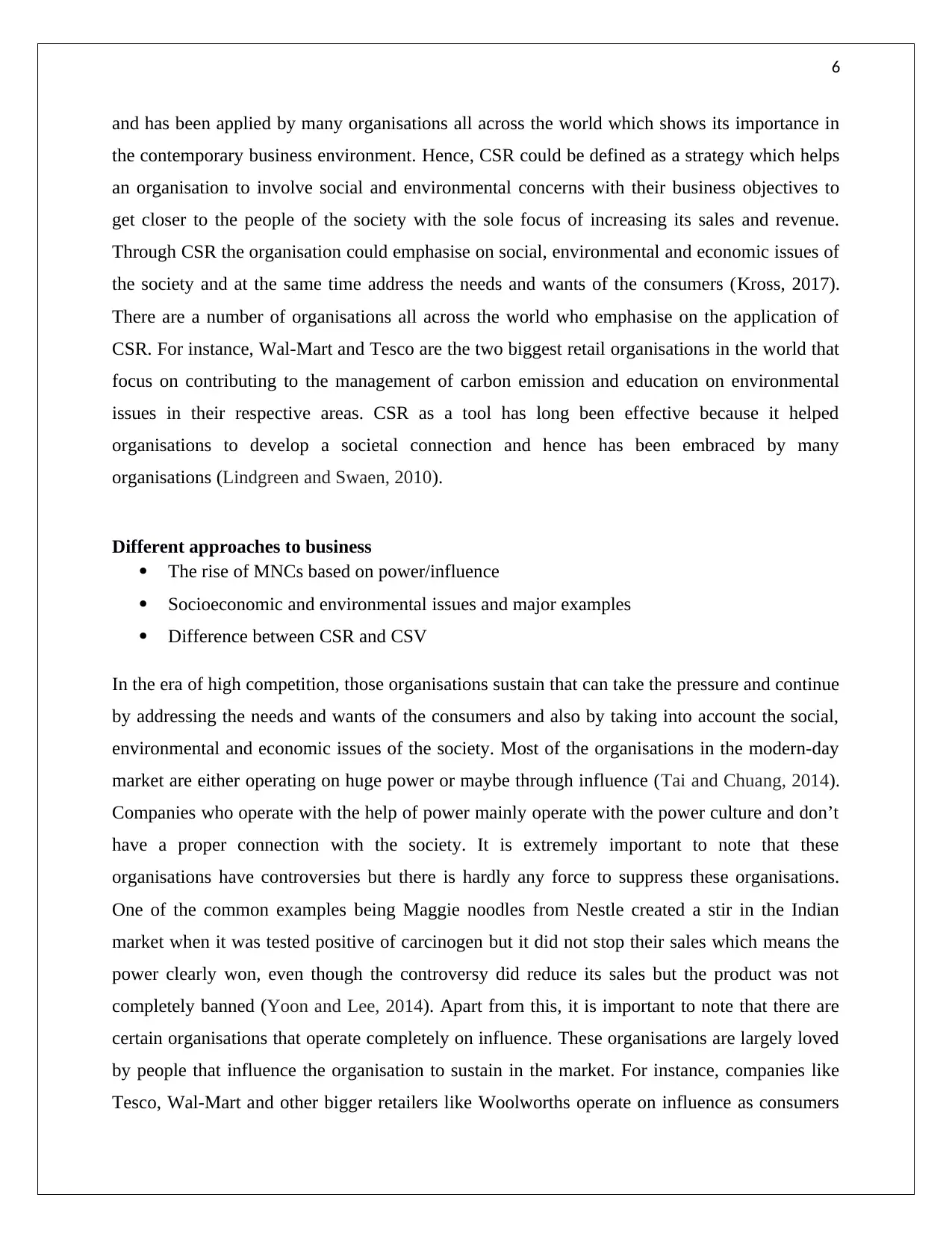
6
and has been applied by many organisations all across the world which shows its importance in
the contemporary business environment. Hence, CSR could be defined as a strategy which helps
an organisation to involve social and environmental concerns with their business objectives to
get closer to the people of the society with the sole focus of increasing its sales and revenue.
Through CSR the organisation could emphasise on social, environmental and economic issues of
the society and at the same time address the needs and wants of the consumers (Kross, 2017).
There are a number of organisations all across the world who emphasise on the application of
CSR. For instance, Wal-Mart and Tesco are the two biggest retail organisations in the world that
focus on contributing to the management of carbon emission and education on environmental
issues in their respective areas. CSR as a tool has long been effective because it helped
organisations to develop a societal connection and hence has been embraced by many
organisations (Lindgreen and Swaen, 2010).
Different approaches to business
The rise of MNCs based on power/influence
Socioeconomic and environmental issues and major examples
Difference between CSR and CSV
In the era of high competition, those organisations sustain that can take the pressure and continue
by addressing the needs and wants of the consumers and also by taking into account the social,
environmental and economic issues of the society. Most of the organisations in the modern-day
market are either operating on huge power or maybe through influence (Tai and Chuang, 2014).
Companies who operate with the help of power mainly operate with the power culture and don’t
have a proper connection with the society. It is extremely important to note that these
organisations have controversies but there is hardly any force to suppress these organisations.
One of the common examples being Maggie noodles from Nestle created a stir in the Indian
market when it was tested positive of carcinogen but it did not stop their sales which means the
power clearly won, even though the controversy did reduce its sales but the product was not
completely banned (Yoon and Lee, 2014). Apart from this, it is important to note that there are
certain organisations that operate completely on influence. These organisations are largely loved
by people that influence the organisation to sustain in the market. For instance, companies like
Tesco, Wal-Mart and other bigger retailers like Woolworths operate on influence as consumers
and has been applied by many organisations all across the world which shows its importance in
the contemporary business environment. Hence, CSR could be defined as a strategy which helps
an organisation to involve social and environmental concerns with their business objectives to
get closer to the people of the society with the sole focus of increasing its sales and revenue.
Through CSR the organisation could emphasise on social, environmental and economic issues of
the society and at the same time address the needs and wants of the consumers (Kross, 2017).
There are a number of organisations all across the world who emphasise on the application of
CSR. For instance, Wal-Mart and Tesco are the two biggest retail organisations in the world that
focus on contributing to the management of carbon emission and education on environmental
issues in their respective areas. CSR as a tool has long been effective because it helped
organisations to develop a societal connection and hence has been embraced by many
organisations (Lindgreen and Swaen, 2010).
Different approaches to business
The rise of MNCs based on power/influence
Socioeconomic and environmental issues and major examples
Difference between CSR and CSV
In the era of high competition, those organisations sustain that can take the pressure and continue
by addressing the needs and wants of the consumers and also by taking into account the social,
environmental and economic issues of the society. Most of the organisations in the modern-day
market are either operating on huge power or maybe through influence (Tai and Chuang, 2014).
Companies who operate with the help of power mainly operate with the power culture and don’t
have a proper connection with the society. It is extremely important to note that these
organisations have controversies but there is hardly any force to suppress these organisations.
One of the common examples being Maggie noodles from Nestle created a stir in the Indian
market when it was tested positive of carcinogen but it did not stop their sales which means the
power clearly won, even though the controversy did reduce its sales but the product was not
completely banned (Yoon and Lee, 2014). Apart from this, it is important to note that there are
certain organisations that operate completely on influence. These organisations are largely loved
by people that influence the organisation to sustain in the market. For instance, companies like
Tesco, Wal-Mart and other bigger retailers like Woolworths operate on influence as consumers
⊘ This is a preview!⊘
Do you want full access?
Subscribe today to unlock all pages.

Trusted by 1+ million students worldwide
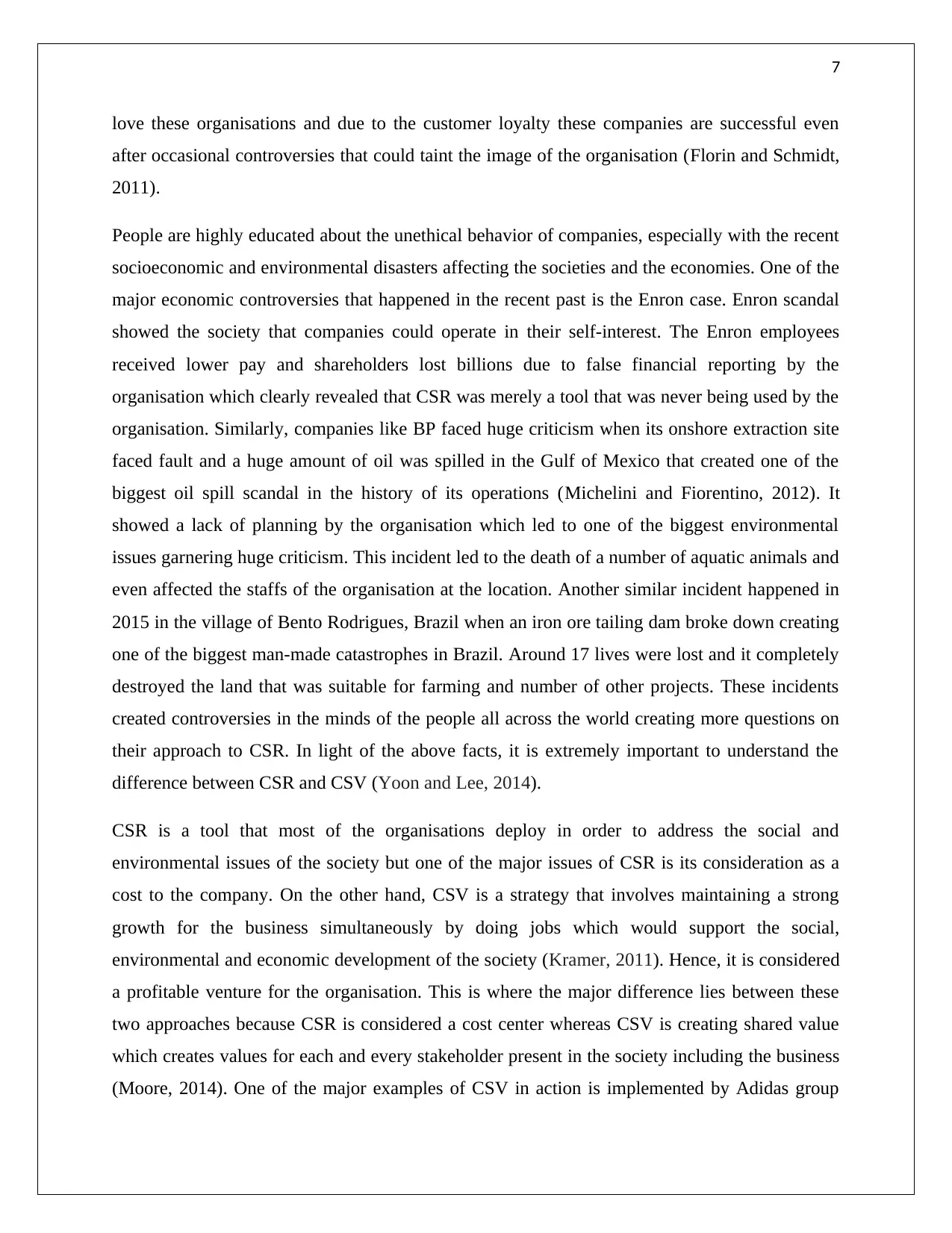
7
love these organisations and due to the customer loyalty these companies are successful even
after occasional controversies that could taint the image of the organisation (Florin and Schmidt,
2011).
People are highly educated about the unethical behavior of companies, especially with the recent
socioeconomic and environmental disasters affecting the societies and the economies. One of the
major economic controversies that happened in the recent past is the Enron case. Enron scandal
showed the society that companies could operate in their self-interest. The Enron employees
received lower pay and shareholders lost billions due to false financial reporting by the
organisation which clearly revealed that CSR was merely a tool that was never being used by the
organisation. Similarly, companies like BP faced huge criticism when its onshore extraction site
faced fault and a huge amount of oil was spilled in the Gulf of Mexico that created one of the
biggest oil spill scandal in the history of its operations (Michelini and Fiorentino, 2012). It
showed a lack of planning by the organisation which led to one of the biggest environmental
issues garnering huge criticism. This incident led to the death of a number of aquatic animals and
even affected the staffs of the organisation at the location. Another similar incident happened in
2015 in the village of Bento Rodrigues, Brazil when an iron ore tailing dam broke down creating
one of the biggest man-made catastrophes in Brazil. Around 17 lives were lost and it completely
destroyed the land that was suitable for farming and number of other projects. These incidents
created controversies in the minds of the people all across the world creating more questions on
their approach to CSR. In light of the above facts, it is extremely important to understand the
difference between CSR and CSV (Yoon and Lee, 2014).
CSR is a tool that most of the organisations deploy in order to address the social and
environmental issues of the society but one of the major issues of CSR is its consideration as a
cost to the company. On the other hand, CSV is a strategy that involves maintaining a strong
growth for the business simultaneously by doing jobs which would support the social,
environmental and economic development of the society (Kramer, 2011). Hence, it is considered
a profitable venture for the organisation. This is where the major difference lies between these
two approaches because CSR is considered a cost center whereas CSV is creating shared value
which creates values for each and every stakeholder present in the society including the business
(Moore, 2014). One of the major examples of CSV in action is implemented by Adidas group
love these organisations and due to the customer loyalty these companies are successful even
after occasional controversies that could taint the image of the organisation (Florin and Schmidt,
2011).
People are highly educated about the unethical behavior of companies, especially with the recent
socioeconomic and environmental disasters affecting the societies and the economies. One of the
major economic controversies that happened in the recent past is the Enron case. Enron scandal
showed the society that companies could operate in their self-interest. The Enron employees
received lower pay and shareholders lost billions due to false financial reporting by the
organisation which clearly revealed that CSR was merely a tool that was never being used by the
organisation. Similarly, companies like BP faced huge criticism when its onshore extraction site
faced fault and a huge amount of oil was spilled in the Gulf of Mexico that created one of the
biggest oil spill scandal in the history of its operations (Michelini and Fiorentino, 2012). It
showed a lack of planning by the organisation which led to one of the biggest environmental
issues garnering huge criticism. This incident led to the death of a number of aquatic animals and
even affected the staffs of the organisation at the location. Another similar incident happened in
2015 in the village of Bento Rodrigues, Brazil when an iron ore tailing dam broke down creating
one of the biggest man-made catastrophes in Brazil. Around 17 lives were lost and it completely
destroyed the land that was suitable for farming and number of other projects. These incidents
created controversies in the minds of the people all across the world creating more questions on
their approach to CSR. In light of the above facts, it is extremely important to understand the
difference between CSR and CSV (Yoon and Lee, 2014).
CSR is a tool that most of the organisations deploy in order to address the social and
environmental issues of the society but one of the major issues of CSR is its consideration as a
cost to the company. On the other hand, CSV is a strategy that involves maintaining a strong
growth for the business simultaneously by doing jobs which would support the social,
environmental and economic development of the society (Kramer, 2011). Hence, it is considered
a profitable venture for the organisation. This is where the major difference lies between these
two approaches because CSR is considered a cost center whereas CSV is creating shared value
which creates values for each and every stakeholder present in the society including the business
(Moore, 2014). One of the major examples of CSV in action is implemented by Adidas group
Paraphrase This Document
Need a fresh take? Get an instant paraphrase of this document with our AI Paraphraser
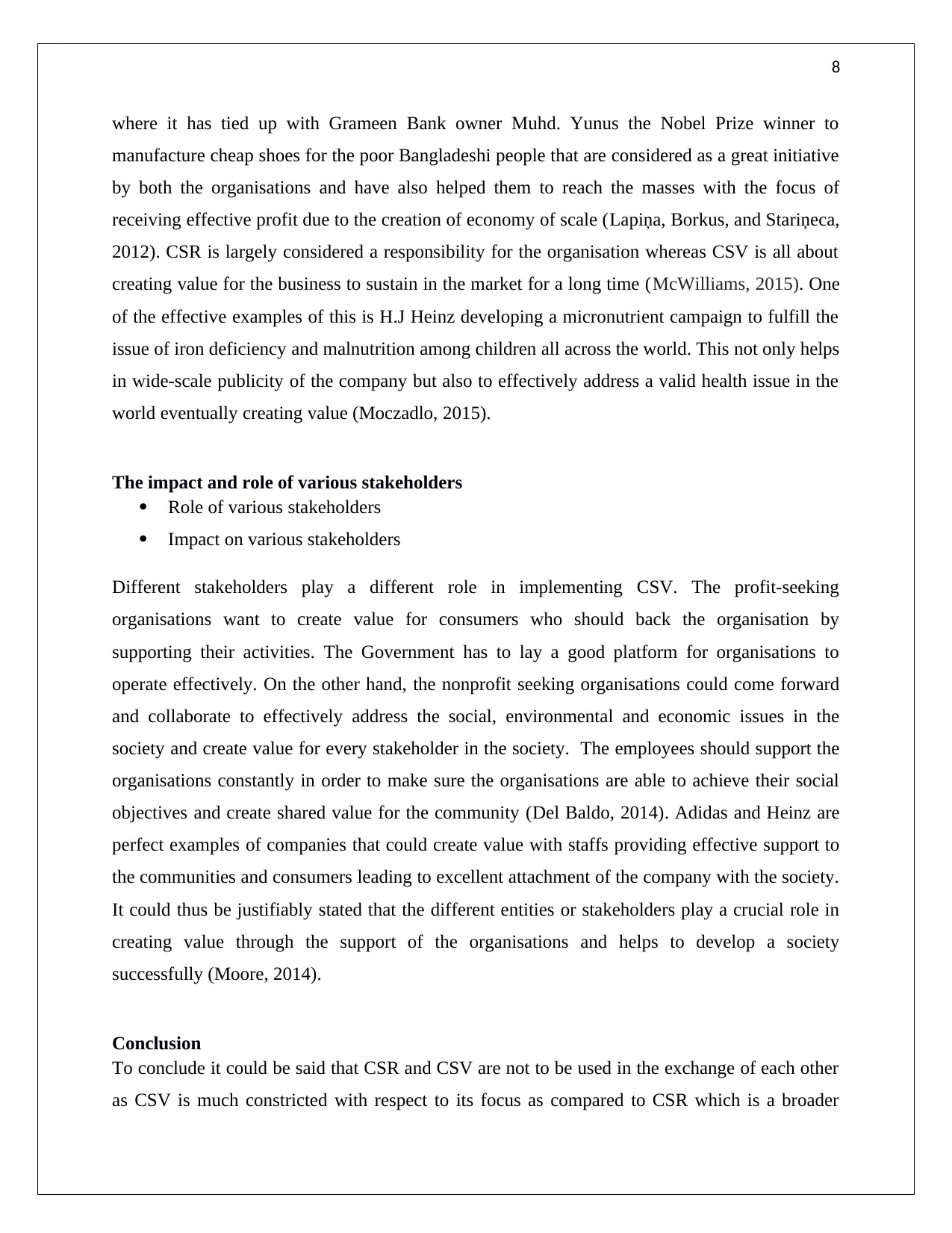
8
where it has tied up with Grameen Bank owner Muhd. Yunus the Nobel Prize winner to
manufacture cheap shoes for the poor Bangladeshi people that are considered as a great initiative
by both the organisations and have also helped them to reach the masses with the focus of
receiving effective profit due to the creation of economy of scale (Lapiņa, Borkus, and Stariņeca,
2012). CSR is largely considered a responsibility for the organisation whereas CSV is all about
creating value for the business to sustain in the market for a long time (McWilliams, 2015). One
of the effective examples of this is H.J Heinz developing a micronutrient campaign to fulfill the
issue of iron deficiency and malnutrition among children all across the world. This not only helps
in wide-scale publicity of the company but also to effectively address a valid health issue in the
world eventually creating value (Moczadlo, 2015).
The impact and role of various stakeholders
Role of various stakeholders
Impact on various stakeholders
Different stakeholders play a different role in implementing CSV. The profit-seeking
organisations want to create value for consumers who should back the organisation by
supporting their activities. The Government has to lay a good platform for organisations to
operate effectively. On the other hand, the nonprofit seeking organisations could come forward
and collaborate to effectively address the social, environmental and economic issues in the
society and create value for every stakeholder in the society. The employees should support the
organisations constantly in order to make sure the organisations are able to achieve their social
objectives and create shared value for the community (Del Baldo, 2014). Adidas and Heinz are
perfect examples of companies that could create value with staffs providing effective support to
the communities and consumers leading to excellent attachment of the company with the society.
It could thus be justifiably stated that the different entities or stakeholders play a crucial role in
creating value through the support of the organisations and helps to develop a society
successfully (Moore, 2014).
Conclusion
To conclude it could be said that CSR and CSV are not to be used in the exchange of each other
as CSV is much constricted with respect to its focus as compared to CSR which is a broader
where it has tied up with Grameen Bank owner Muhd. Yunus the Nobel Prize winner to
manufacture cheap shoes for the poor Bangladeshi people that are considered as a great initiative
by both the organisations and have also helped them to reach the masses with the focus of
receiving effective profit due to the creation of economy of scale (Lapiņa, Borkus, and Stariņeca,
2012). CSR is largely considered a responsibility for the organisation whereas CSV is all about
creating value for the business to sustain in the market for a long time (McWilliams, 2015). One
of the effective examples of this is H.J Heinz developing a micronutrient campaign to fulfill the
issue of iron deficiency and malnutrition among children all across the world. This not only helps
in wide-scale publicity of the company but also to effectively address a valid health issue in the
world eventually creating value (Moczadlo, 2015).
The impact and role of various stakeholders
Role of various stakeholders
Impact on various stakeholders
Different stakeholders play a different role in implementing CSV. The profit-seeking
organisations want to create value for consumers who should back the organisation by
supporting their activities. The Government has to lay a good platform for organisations to
operate effectively. On the other hand, the nonprofit seeking organisations could come forward
and collaborate to effectively address the social, environmental and economic issues in the
society and create value for every stakeholder in the society. The employees should support the
organisations constantly in order to make sure the organisations are able to achieve their social
objectives and create shared value for the community (Del Baldo, 2014). Adidas and Heinz are
perfect examples of companies that could create value with staffs providing effective support to
the communities and consumers leading to excellent attachment of the company with the society.
It could thus be justifiably stated that the different entities or stakeholders play a crucial role in
creating value through the support of the organisations and helps to develop a society
successfully (Moore, 2014).
Conclusion
To conclude it could be said that CSR and CSV are not to be used in the exchange of each other
as CSV is much constricted with respect to its focus as compared to CSR which is a broader
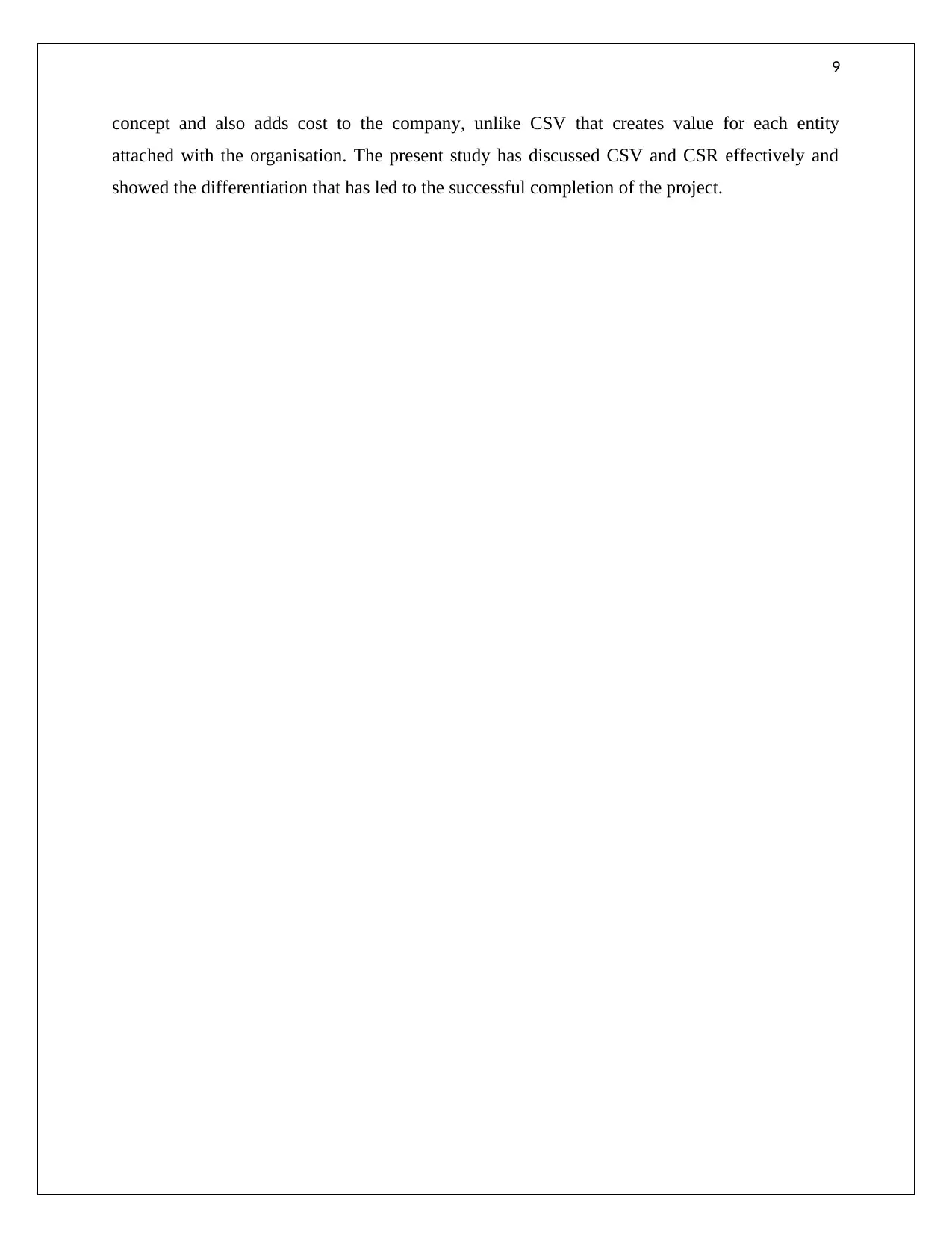
9
concept and also adds cost to the company, unlike CSV that creates value for each entity
attached with the organisation. The present study has discussed CSV and CSR effectively and
showed the differentiation that has led to the successful completion of the project.
concept and also adds cost to the company, unlike CSV that creates value for each entity
attached with the organisation. The present study has discussed CSV and CSR effectively and
showed the differentiation that has led to the successful completion of the project.
⊘ This is a preview!⊘
Do you want full access?
Subscribe today to unlock all pages.

Trusted by 1+ million students worldwide
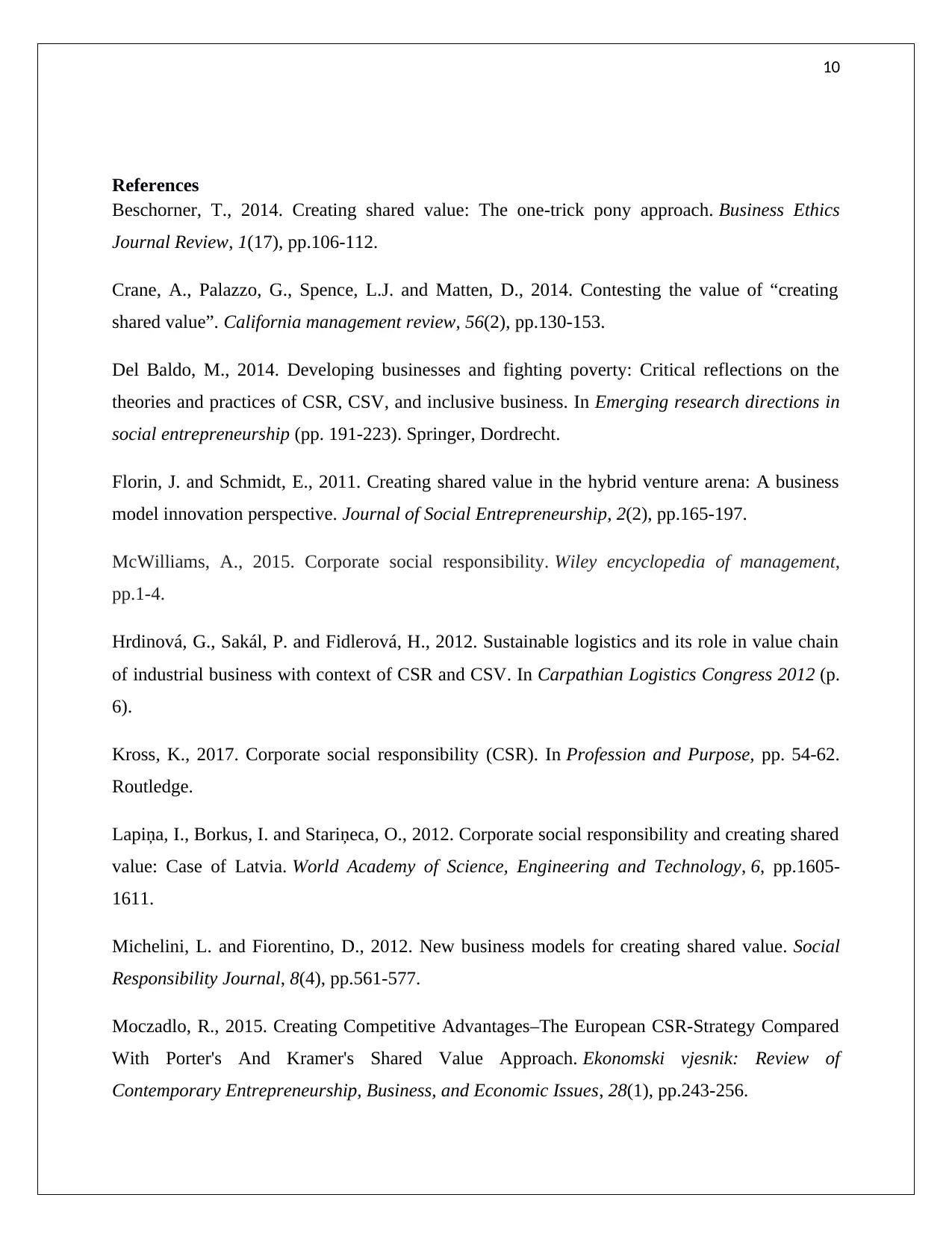
10
References
Beschorner, T., 2014. Creating shared value: The one-trick pony approach. Business Ethics
Journal Review, 1(17), pp.106-112.
Crane, A., Palazzo, G., Spence, L.J. and Matten, D., 2014. Contesting the value of “creating
shared value”. California management review, 56(2), pp.130-153.
Del Baldo, M., 2014. Developing businesses and fighting poverty: Critical reflections on the
theories and practices of CSR, CSV, and inclusive business. In Emerging research directions in
social entrepreneurship (pp. 191-223). Springer, Dordrecht.
Florin, J. and Schmidt, E., 2011. Creating shared value in the hybrid venture arena: A business
model innovation perspective. Journal of Social Entrepreneurship, 2(2), pp.165-197.
McWilliams, A., 2015. Corporate social responsibility. Wiley encyclopedia of management,
pp.1-4.
Hrdinová, G., Sakál, P. and Fidlerová, H., 2012. Sustainable logistics and its role in value chain
of industrial business with context of CSR and CSV. In Carpathian Logistics Congress 2012 (p.
6).
Kross, K., 2017. Corporate social responsibility (CSR). In Profession and Purpose, pp. 54-62.
Routledge.
Lapiņa, I., Borkus, I. and Stariņeca, O., 2012. Corporate social responsibility and creating shared
value: Case of Latvia. World Academy of Science, Engineering and Technology, 6, pp.1605-
1611.
Michelini, L. and Fiorentino, D., 2012. New business models for creating shared value. Social
Responsibility Journal, 8(4), pp.561-577.
Moczadlo, R., 2015. Creating Competitive Advantages–The European CSR-Strategy Compared
With Porter's And Kramer's Shared Value Approach. Ekonomski vjesnik: Review of
Contemporary Entrepreneurship, Business, and Economic Issues, 28(1), pp.243-256.
References
Beschorner, T., 2014. Creating shared value: The one-trick pony approach. Business Ethics
Journal Review, 1(17), pp.106-112.
Crane, A., Palazzo, G., Spence, L.J. and Matten, D., 2014. Contesting the value of “creating
shared value”. California management review, 56(2), pp.130-153.
Del Baldo, M., 2014. Developing businesses and fighting poverty: Critical reflections on the
theories and practices of CSR, CSV, and inclusive business. In Emerging research directions in
social entrepreneurship (pp. 191-223). Springer, Dordrecht.
Florin, J. and Schmidt, E., 2011. Creating shared value in the hybrid venture arena: A business
model innovation perspective. Journal of Social Entrepreneurship, 2(2), pp.165-197.
McWilliams, A., 2015. Corporate social responsibility. Wiley encyclopedia of management,
pp.1-4.
Hrdinová, G., Sakál, P. and Fidlerová, H., 2012. Sustainable logistics and its role in value chain
of industrial business with context of CSR and CSV. In Carpathian Logistics Congress 2012 (p.
6).
Kross, K., 2017. Corporate social responsibility (CSR). In Profession and Purpose, pp. 54-62.
Routledge.
Lapiņa, I., Borkus, I. and Stariņeca, O., 2012. Corporate social responsibility and creating shared
value: Case of Latvia. World Academy of Science, Engineering and Technology, 6, pp.1605-
1611.
Michelini, L. and Fiorentino, D., 2012. New business models for creating shared value. Social
Responsibility Journal, 8(4), pp.561-577.
Moczadlo, R., 2015. Creating Competitive Advantages–The European CSR-Strategy Compared
With Porter's And Kramer's Shared Value Approach. Ekonomski vjesnik: Review of
Contemporary Entrepreneurship, Business, and Economic Issues, 28(1), pp.243-256.
Paraphrase This Document
Need a fresh take? Get an instant paraphrase of this document with our AI Paraphraser
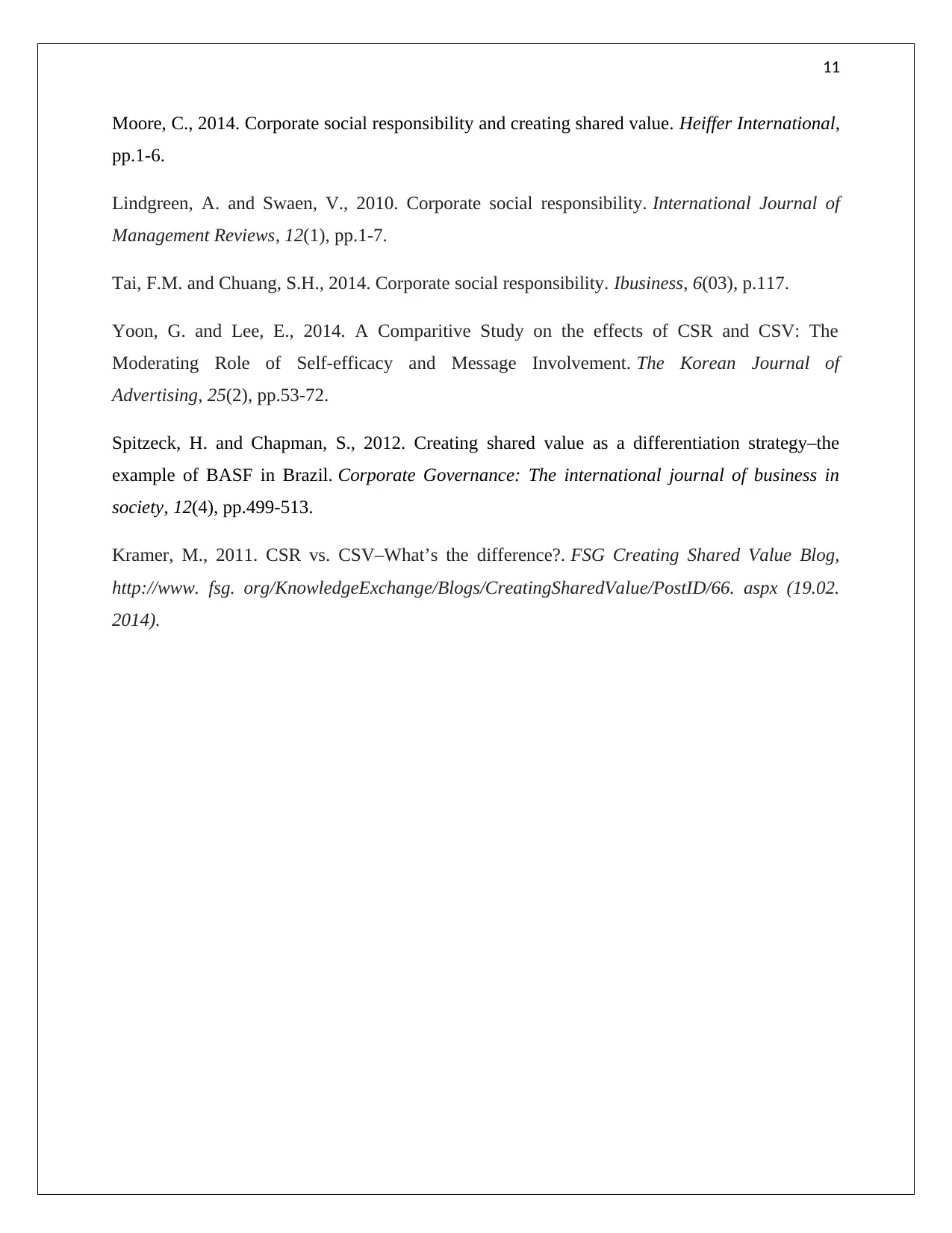
11
Moore, C., 2014. Corporate social responsibility and creating shared value. Heiffer International,
pp.1-6.
Lindgreen, A. and Swaen, V., 2010. Corporate social responsibility. International Journal of
Management Reviews, 12(1), pp.1-7.
Tai, F.M. and Chuang, S.H., 2014. Corporate social responsibility. Ibusiness, 6(03), p.117.
Yoon, G. and Lee, E., 2014. A Comparitive Study on the effects of CSR and CSV: The
Moderating Role of Self-efficacy and Message Involvement. The Korean Journal of
Advertising, 25(2), pp.53-72.
Spitzeck, H. and Chapman, S., 2012. Creating shared value as a differentiation strategy–the
example of BASF in Brazil. Corporate Governance: The international journal of business in
society, 12(4), pp.499-513.
Kramer, M., 2011. CSR vs. CSV–What’s the difference?. FSG Creating Shared Value Blog,
http://www. fsg. org/KnowledgeExchange/Blogs/CreatingSharedValue/PostID/66. aspx (19.02.
2014).
Moore, C., 2014. Corporate social responsibility and creating shared value. Heiffer International,
pp.1-6.
Lindgreen, A. and Swaen, V., 2010. Corporate social responsibility. International Journal of
Management Reviews, 12(1), pp.1-7.
Tai, F.M. and Chuang, S.H., 2014. Corporate social responsibility. Ibusiness, 6(03), p.117.
Yoon, G. and Lee, E., 2014. A Comparitive Study on the effects of CSR and CSV: The
Moderating Role of Self-efficacy and Message Involvement. The Korean Journal of
Advertising, 25(2), pp.53-72.
Spitzeck, H. and Chapman, S., 2012. Creating shared value as a differentiation strategy–the
example of BASF in Brazil. Corporate Governance: The international journal of business in
society, 12(4), pp.499-513.
Kramer, M., 2011. CSR vs. CSV–What’s the difference?. FSG Creating Shared Value Blog,
http://www. fsg. org/KnowledgeExchange/Blogs/CreatingSharedValue/PostID/66. aspx (19.02.
2014).
1 out of 11
Related Documents
Your All-in-One AI-Powered Toolkit for Academic Success.
+13062052269
info@desklib.com
Available 24*7 on WhatsApp / Email
![[object Object]](/_next/static/media/star-bottom.7253800d.svg)
Unlock your academic potential
Copyright © 2020–2025 A2Z Services. All Rights Reserved. Developed and managed by ZUCOL.





